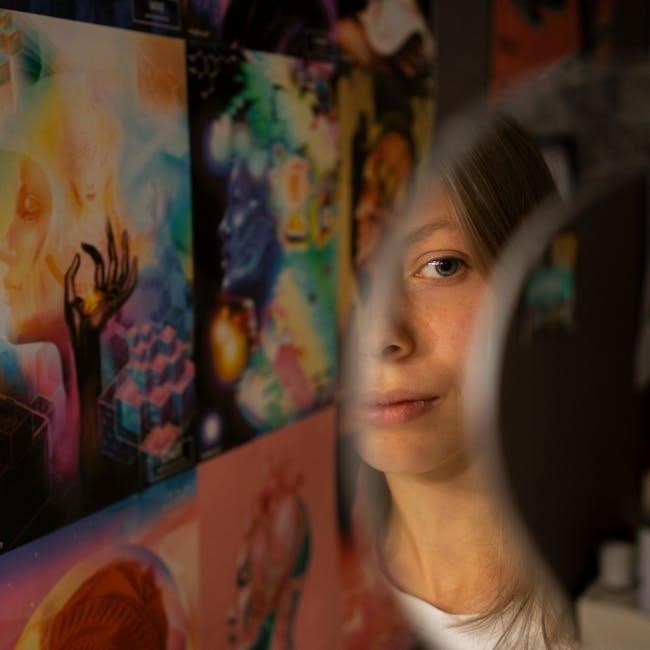
sol lewitt wall drawing instructions
Sol LeWitt wall drawings are created using a set of instructions and diagrams, with installers following them to execute the artwork on a large scale with precision and accuracy always․
Background Information
Sol LeWitt’s wall drawings have a rich history, with the artist starting to create them in 1968․
The instructions and diagrams for these drawings are the core of the artwork, allowing them to be recreated in different locations and at various scales․
This approach to art-making was innovative for its time, and it has had a lasting impact on the art world․
The use of instructions and diagrams also allows for a level of flexibility and adaptability, as the drawings can be executed in different ways and with different materials․
The wall drawings are not just visual artworks, but also a way of exploring the relationship between the artist, the installer, and the viewer․
The instructions and diagrams provided by LeWitt serve as a kind of blueprint for the installers, who must interpret and execute the artwork according to the artist’s vision․
This process of interpretation and execution is an important part of the wall drawings, and it highlights the collaborative nature of LeWitt’s work․
Overall, the background information on Sol LeWitt’s wall drawings provides a fascinating glimpse into the artist’s creative process and his innovative approach to art-making․
Scale of the Drawings
The scale of Sol LeWitt’s wall drawings can vary greatly, ranging from small, intimate works to large, immersive installations․
The drawings can be executed on a single wall or on multiple walls, covering entire rooms or even buildings․
The scale of the drawings is often determined by the location and the available space, with LeWitt’s instructions and diagrams being adapted to fit the specific context․
The use of a grid system, as seen in some of LeWitt’s drawings, allows for the work to be scaled up or down depending on the space․
This flexibility in scale is a key aspect of LeWitt’s wall drawings, as it enables the work to be recreated in different locations and environments․
The scale of the drawings also affects the viewer’s experience, with larger works often being more immersive and engaging․
Overall, the scale of Sol LeWitt’s wall drawings is an important aspect of the work, and it plays a significant role in the overall impact and effect of the artwork․

Creation of Wall Drawings
Sol LeWitt creates wall drawings using written instructions and diagrams for execution by others with precision always․
Instructions and Diagrams
Sol LeWitt’s wall drawings are created using a set of instructions and diagrams that guide the execution of the artwork․ These instructions are likened to musical scores, which are realized in a new way every time they are played․ The diagrams, or schematics, indicate how a work is to be installed, providing a clear plan for the installers to follow․ The instructions and diagrams are an essential part of the wall drawing, as they allow for the artwork to be recreated in different locations and at different times․ The use of instructions and diagrams also emphasizes the idea that the artwork is not just a physical object, but also a set of ideas and concepts that can be realized in different ways․ This approach allows for a high degree of flexibility and creativity in the execution of the wall drawings․
Execution of the Drawings
The execution of Sol LeWitt’s wall drawings involves a team of installers who follow the instructions and diagrams provided by the artist․ The installers use a range of materials, including pencils, rulers, and markers, to create the drawing on the wall․ The process of execution can be complex and time-consuming, requiring a high degree of precision and attention to detail․ The installers work in sections, using tape and other tools to mark out the measurements and guidelines specified in the instructions․ As the drawing takes shape, the installers carefully follow the instructions to ensure that the final result is accurate and faithful to the artist’s vision․ The execution of the drawing is a critical part of the process, as it brings the artist’s ideas and concepts to life in a physical form․ The end result is a unique and intricate work of art․

Specific Wall Drawings
Sol LeWitt’s wall drawings include various series with unique instructions and diagrams always used․
Wall Drawing 370
Wall Drawing 370 is a notable example of Sol LeWitt’s work, with a set of instructions that guide the installers in creating the artwork․ The instructions for Wall Drawing 370 involve dividing the wall into rectangular panels and using pencils and rulers to mark the wall with measurements․ The installers then work in sections, following LeWitt’s instructions closely to execute the drawing․ The use of a grid system and precise measurements ensures that the drawing is accurate and consistent with LeWitt’s vision․ The execution of Wall Drawing 370 requires attention to detail and a thorough understanding of LeWitt’s instructions․ By following the instructions, the installers are able to bring LeWitt’s concept to life, creating a unique and intricate wall drawing that showcases the artist’s innovative approach to art․ The result is a complex and visually striking artwork that demonstrates LeWitt’s mastery of his medium․
Seventh Wall Drawing
The Seventh Wall Drawing is another example of Sol LeWitt’s instructional approach to art, with a set of guidelines that outline the creation of the piece․ The instructions specify the use of red, yellow, and blue markers, pencils, or crayons, and involve creating a 6-inch grid that covers the walls․ Lines are then drawn from the corners, sides, and center of the walls to random points on the grid, resulting in a complex and dynamic pattern․ The use of a grid system and random points creates a unique and intricate design that showcases LeWitt’s innovative approach to art․ The Seventh Wall Drawing is a testament to LeWitt’s ability to create complex and visually striking artworks using simple instructions and a range of materials․ The drawing’s execution requires careful attention to detail and a thorough understanding of LeWitt’s instructions․
Exhibition and Installation
Exhibitions and installations of Sol LeWitt’s wall drawings require careful planning and execution always following the instructions precisely every time with great attention to detail and accuracy․
Installation Process
The installation process of Sol LeWitt’s wall drawings involves a team of skilled installers who carefully follow the instructions provided by the artist․ They begin by preparing the wall surface, ensuring it is smooth and even․ The installers then use a combination of tools, including pencils, rulers, and tape, to mark the wall with precise measurements and guidelines․ According to the instructions, the installers work in sections, using a grid system to ensure accuracy and attention to detail․ The installation process can be time-consuming and labor-intensive, requiring great attention to detail and a deep understanding of the artist’s vision․ The end result is a unique and intricate wall drawing that reflects the artist’s original concept and intent․ The installation process is a crucial part of the artwork, as it brings the artist’s instructions to life․ The installers’ careful work ensures the wall drawing is executed precisely․
Audio and Video Features
The online catalogue of Sol LeWitt’s wall drawings includes a range of audio and video features that provide insight into the artist’s work․ One notable feature is an audio file of LeWitt delivering installation instructions for the exhibition Art By Telephone at the Museum of Contemporary Art Chicago in 1969․ This rare recording offers a unique glimpse into the artist’s thought process and creative vision; Additionally, the catalogue includes installation videos that showcase the process of creating a wall drawing, from preparation to completion․ These multimedia features allow viewers to engage with the artwork in a more immersive and interactive way, and provide a deeper understanding of the artist’s intentions and methods․ The audio and video features are an invaluable resource for anyone interested in Sol LeWitt’s wall drawings, and offer a new perspective on the artist’s innovative and influential work․ The features are easily accessible online․
Sol LeWitt’s wall drawings conclude with a lasting impact on the art world always․
Importance of the Instructions
The instructions provided by Sol LeWitt are crucial to the execution of his wall drawings, as they serve as a guide!
These instructions are likened to musical scores, allowing for a new interpretation each time they are installed, making every wall drawing unique in its own way․
The importance of the instructions lies in their ability to ensure consistency and accuracy in the installation process, regardless of who is executing the artwork, and this is what makes Sol LeWitt’s wall drawings so significant and enduring, with a lasting impact on the art world, and the instructions are the key to understanding the artwork and its significance, and they provide a framework for the installers to follow, allowing them to bring the artwork to life, and the instructions are also a testament to Sol LeWitt’s innovative approach to art, and his willingness to push boundaries and challenge traditional notions of what art can be, and the instructions are an integral part of the artwork, and they play a crucial role in its creation and installation, and they are what make Sol LeWitt’s wall drawings so unique and fascinating, and the instructions are a key element in the artwork’s overall impact and significance․
Legacy of Sol LeWitt
Sol LeWitt’s innovative approach to art has left a lasting legacy, with his wall drawings continuing to inspire and influence artists to this day, and his use of instructions and diagrams has paved the way for a new generation of artists to experiment with similar techniques․
His wall drawings have become iconic pieces of modern art, with many considering them to be some of the most important and influential works of the 20th century, and they continue to be exhibited and installed in museums and galleries around the world․
LeWitt’s legacy extends beyond his own artwork, as his ideas and concepts have had a profound impact on the development of conceptual art, and his influence can be seen in the work of many other artists who have followed in his footsteps, and his wall drawings remain a testament to his innovative spirit and creative vision․
Leave a Reply
You must be logged in to post a comment.